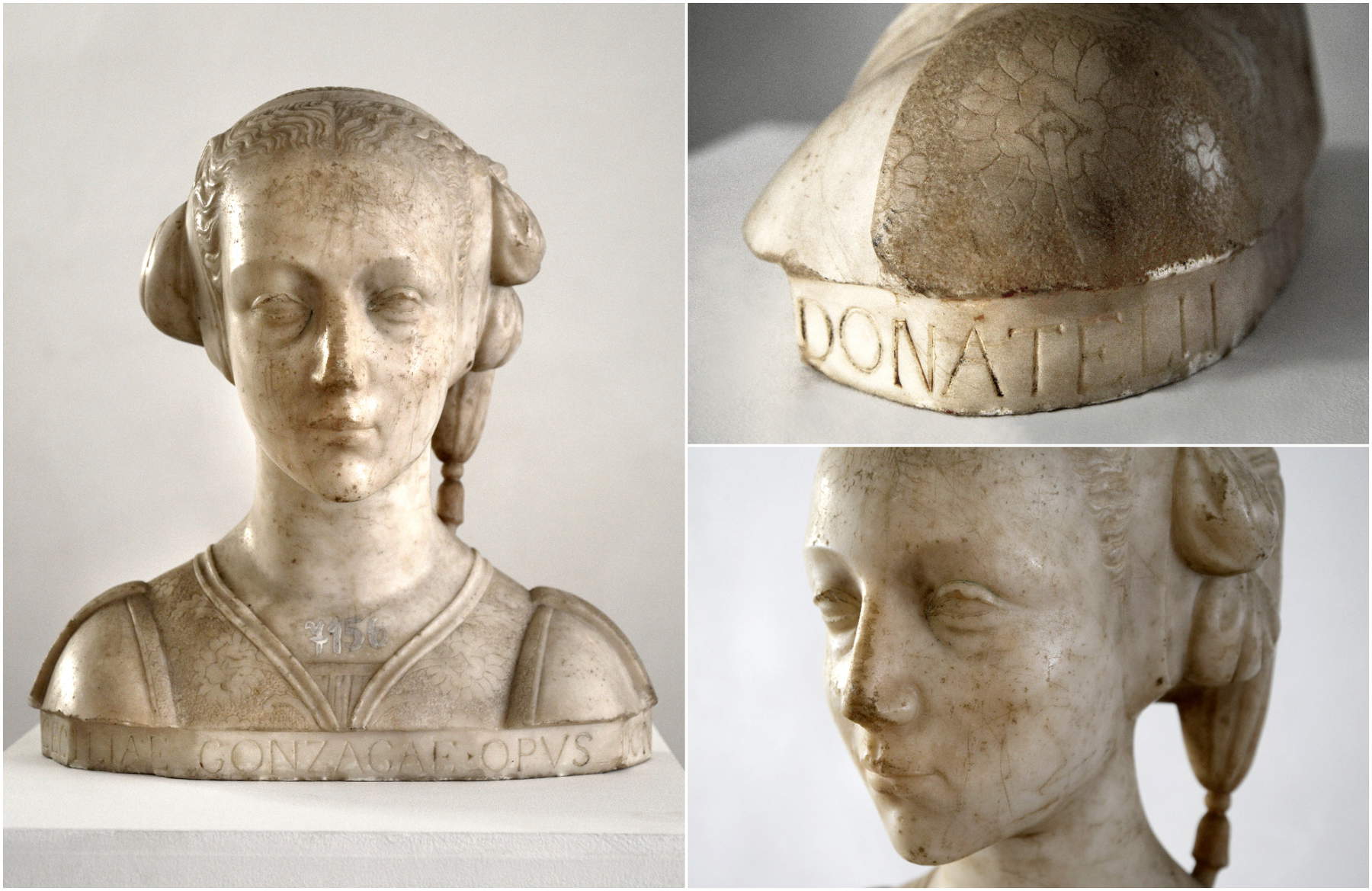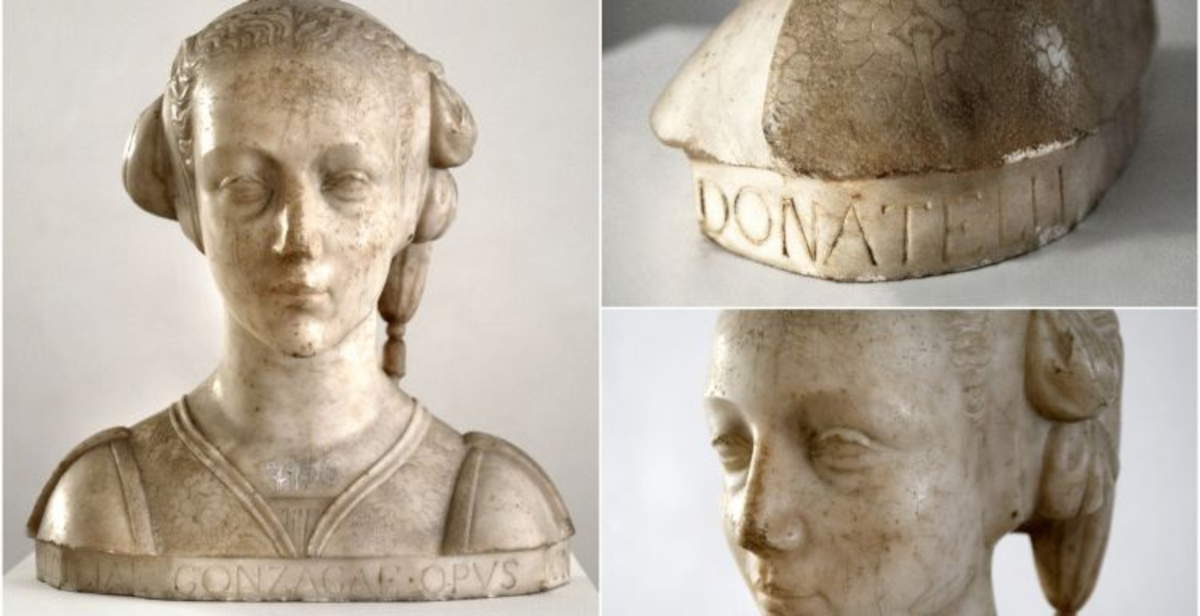Do you remember the bust attributed to Donatello that popped up a few months ago in Slovakia, displayed at the Spiš Museum in Levoča and has been talked about for some time by us as well?Well, at the end of last May, the same marble bust attributed to the Italian artist (the Opera di Santa Maria del Fiore, as we had reported on these pages, categorically denies that any opinion was ever expressed on the attribution of the work to Donatello) was removed in a highly rocambolic manner from the Spiš Museum. The bust, a few days ago, was in fact taken from the museum during a raid by some government officials with their faces covered by balaclavas. The work was then moved to an undisclosed location, while for days the Slovak government remained silent, neither revealing its whereabouts nor providing any explanation for what happened.
The work, which allegedly depicts Renaissance noblewoman Cecilia Gonzaga, had been found in a museum storage room by historian Marta Herucová, and its attribution to the Florentine sculptor had been speculated on the basis of the inscription “Opus Donatelli” on the base, similar to that found on other certain works by the Tuscan master. News of the discovery and attribution had been officially released last February, and since then the work has suddenly become the subject of strong political and institutional interest in Slovakia.
The attribution, it must be said, is far from certain. The bust, carved from Carrara marble, has never been subjected to in-depth analysis that could accurately confirm its authorship, nor has it ever been on public display. Until the recent discovery, it was considered a later copy from the time of Donatello, who lived between 1386 and 1466. In the past, the work belonged to the aristocratic Hungarian Csáky family, which later fled Czechoslovakia during World War II. The bust was located in the family palace in Spišský Hrhov, which was turned into a reformatory by the communist regime after the war. It was not until 1975 that it was officially entrusted to the museum in Levoča, where it remained in storage and ignored by critics until the recent intervention by historian Herucová.

The bust has never been shown to the public and, apart from a few photographs, the only way to observe it is through a 3D scan made available by the museum on the Sketchfab portal. Uncertainties about attribution to Donatello also stem from the fact that, until now, in-depth analyses have not been possible, and the handling of the discovery has certainly not helped to make them easier. Then, in late May, an official of the Ministry of Culture, Lukáš Machala, put in the operation we mentioned above. Machala, a trusted man of Culture Minister Martina Šimkovičová, an expression of the ultranationalist SNS party, is part of a cohort that in recent months has launched a campaign of purges within Slovak cultural institutions. The move to remove the bust from the museum had not been announced to either the authorities or the citizens of Levoča, and its purposes appeared unclear from the outset. In addition to the methods adopted, the action was also harshly criticized for its apparent lack of precautions.
Machala, the ministry’s current secretary general, went to the museum depot along with a group of people with their faces covered by balaclavas, accompanied by a police escort. A local television station captured the scene, but was instructed not to broadcast the footage until the move was completed. The group, similar to a small commando, did not reveal the statue’s destination. The minister also maintained silence for days, and only on June 3 did she provide an explanation via her Facebook profile, speaking of security reasons, but only after the operation was over.

“The Ministry of Culture has taken extraordinary security measures to ensure the protection of an exceptionally rare collector’s item - the bust of Cecilia Gonzaga, attributed to the important Italian Renaissance master Donatello,” wrote Minister Martina Šimkovičová in her post. “This unique artifact from the 15th century, owned by the Slovak Republic, represents a work of art of extraordinary historical, cultural and social value. The Ministry of Culture proceeded in close cooperation with the Slovak National Museum, the police force and other specialized components of the Ministry of the Interior of the Slovak Republic. Since the local storage facilities at the Spiš Museum in Levoča do not meet the highest security standards necessary for the storage of such exceptionally important collectibles, it was necessary to approach an extraordinary solution. Questions regarding the transportation and storage of the collection object were discussed with the Chairman of the Police Department. Based on the agreement, the storage location was determined within the organizational structure of the Slovak Ministry of the Interior. Any detailed information on the process or specific storage location is not public. Since the transportation and storage of a collection object was a strict confidentiality regime, we urge the public and the media not to share sensitive information.”
“In this context,” the minister continued, “it is necessary to correctly mention some misleading statements that have appeared in the public space in recent days. The Ministry of Culture firmly rejects any accusations of arbitrary or illegal activity. The process of relocating and depositing the bust was carried out in full compliance with the law, in close cooperation with experts and security forces. Former Minister of Culture Natália Milanová, as well as the management of the Slovak National Museum under the leadership of Branislav Panis, according to available documentation, showed no professional or operational interest in the discovery and neglected their obligation to take steps to secure the collector’s item according to the law. A masterpiece like the bust of Cecilia Gonzaga cannot be stored in a standard repository. Adding a lock to the door is not enough. It needs a comprehensive security regime at a level that no museum or gallery in Slovakia currently encounters. Saving a collector’s item is a matter of preservation, not lending, as erroneously stated. With regard to the conditions of preservation of a collectible object, the standards commonly reserved for artifacts made of natural stone, in this case Carrara marble, have been applied. Such work should not be exposed to direct sunlight, the relative humidity should be around 50 percent, and the temperature between 18 and 20 °C. These conditions are also currently observed. Therefore, the professional care and protection regime are appropriate and correspond to the character and value of the object.”
“The Ministry of Culture,” Šimkovičová concludes, “reiterates that the protocol for taking over the work was prepared and signed on site. Two restorers present at the handover, one for the Ministry of Culture and the other for the Spiš Museum in Levoča, documented the condition of the bust in the protocol, including photographic documentation in digital and printed format. The entire process was carried out according to the highest professional and security standards, and in addition to the National Museum of Slovakia, members of the Ministry of the Interior, the Slovak Police Force, and other experts participated in its preparation for several weeks. Thus, the Ministry of Culture assures the public, the professional community, and international institutions that all measures taken in connection with the bust of Cecilia Gonzaga were conducted in accordance with the Slovak legal system and international standards, taking into account the recommendations of experts, not to mention the ethical aspects of this decision. In light of a confidentiality regime in place regarding the preservation of a collector’s item, we urge the public and the media to consider any additional information about its location. Compliance with this regime is essential for security reasons and is in the interest of protecting the national cultural heritage. Please note that in the event of deliberate or negligent disclosure of information that could jeopardize the safety of the collection object or illegal action, legal action will be taken in accordance with applicable laws.”

After the minister’s statements, we also gathered the opinion of the former director of the Spiš Museum, Mária Novotná, and asked her two very specific questions trying to better understand the situation. We asked her, meanwhile, whether it is true, as the minister claims, that the Spiš Museum does not provide adequate security conditions for the bust.
The Museum is part of the Slovak National Museum and, as such, has a vast collection with a multitude of valuable artifacts in its storerooms, protected to the same standards as any museum of its size, with a security service, coded locks, motion sensors and fire alarms, among many other measures. That said, there is always room for improvement, so any problems can be solved with financial investment. The Ministry is responsible for the Museum’s budget.
“It is not,” Novotná told us. “The Museum is part of the Slovak National Museum and, as such, has a large collection with a multitude of valuable artifacts in its storerooms, protected to the same standards as any museum of its size, with a security service, coded locks, motion sensors and fire alarms, among many other measures. That said, there is always room for improvement, so any problems can be solved with financial investment. The Ministry is responsible for the Museum’s budget.” When asked what she thinks the fate of the artwork will be, that is, whether it will be returned to the museum or not, even in light of the fact that so far the minister has made no statements regarding the bust’s future, the director can only hope that the ministry will remedy the situation. “The bust,” she tells us, “should be entrusted to the care and custody of the museum, in accordance with the law, since it is part of its (state-owned) collection. It is not the Ministry’s responsibility to take care of works of art. We do not know the Ministry’s actual plans. Their statements change. In the first communication to the Slovak media, they stated that the main reason was the safe storage of the work in a space owned by the Slovak police. This is a place not equipped primarily as a museum and gallery. At the same time, they informed that they would consult two foreign experts. The expert analysis of the bust should be concerned with ascertaining authorship (establishing originality) and determining the value of the work. The exact terms of reference and objective of the analysis have not been published by the Ministry. Such a procedure by the Ministry has never been registered in Slovakia. Local government (the city of Levoča and the Spiš region) and Slovak civil society do not agree with the Ministry’s procedure. We still do not know what the ministry’s actual plans are for the bust, so I cannot say at the moment whether the bust will return to the museum that acquired it 50 years ago, had it in its collection, and has supported its scientific research for the past 6 years. It is possible that it will be displayed in the Slovak National Gallery without the museum’s consent, but even that is unclear at the moment.”
At this time, the museum has not issued any official statement regarding the bust’s status, nor has it provided any contextual elements useful for better understanding its position or assessing the accuracy of recent media coverage and ministerial statements. Thus, it remains to be seen what the future of the work, which is still shrouded in uncertainty and silence, will be.
 |
| Slovakia, third-world scenes! Ministry commandeers work attributed to Donatello in movie-like action |
Warning: the translation into English of the original Italian article was created using automatic tools. We undertake to review all articles, but we do not guarantee the total absence of inaccuracies in the translation due to the program. You can find the original by clicking on the ITA button. If you find any mistake,please contact us.